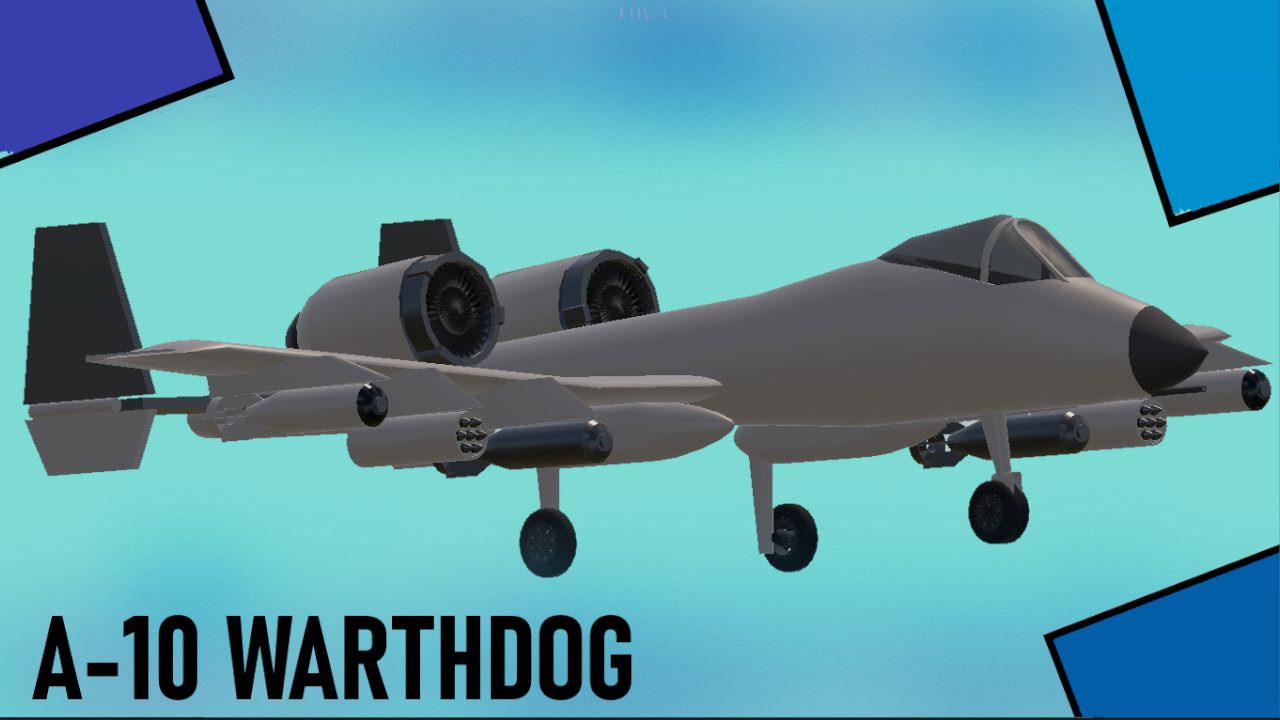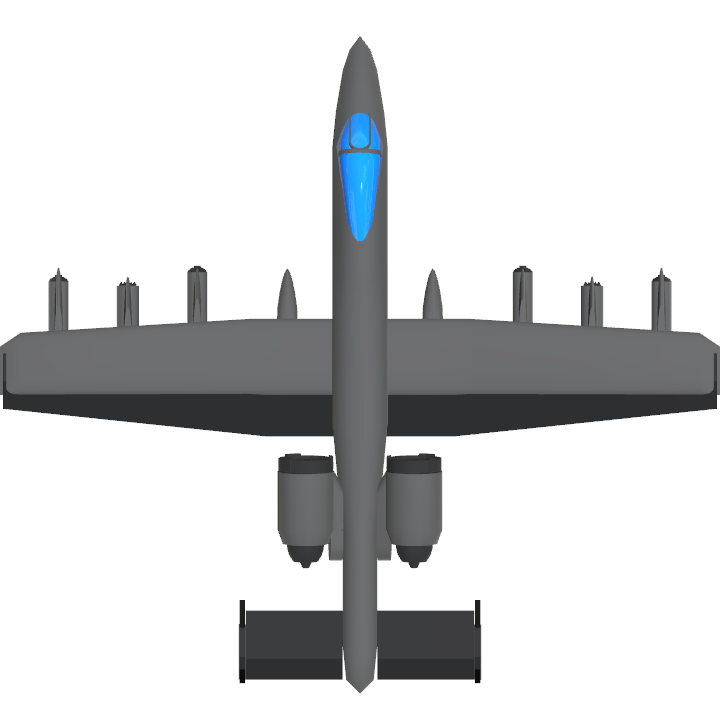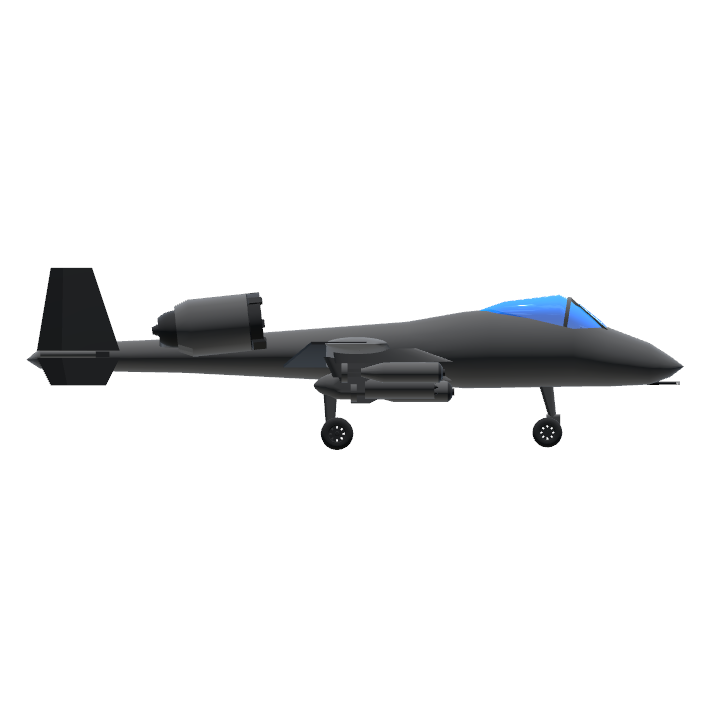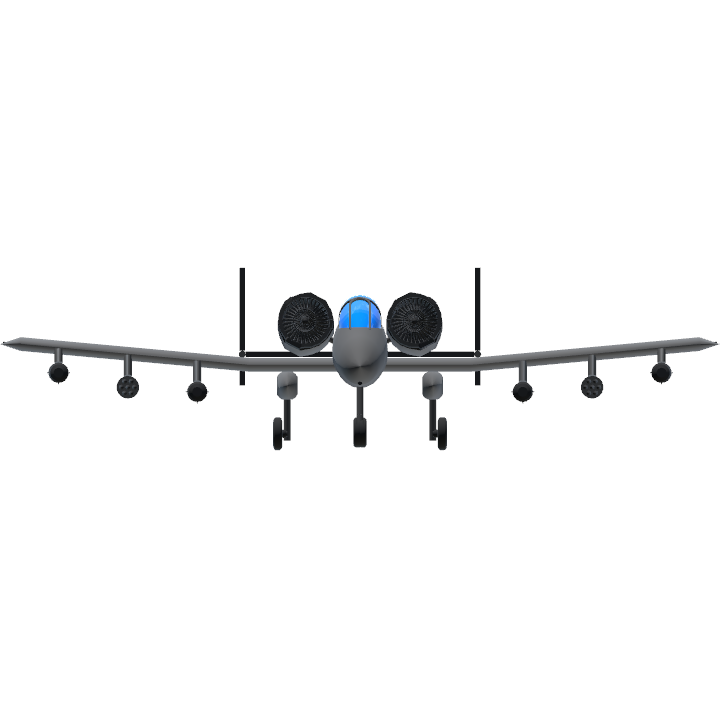The A-10 Warthdog
The Fairchild Republic A-10 Thunderbolt II is a single-seat, twin-turbofan, straight-wing, subsonic attack aircraft developed by Fairchild Republic for the United States Air Force (USAF). In service since 1977, it is named after the Republic P-47 Thunderbolt, but is commonly referred to as the "Warthog" or simply "Hog".[3] The A-10 was designed to provide close air support (CAS) to ground troops by attacking enemy armored vehicles, tanks, and other ground forces; it is the only production-built aircraft designed solely for CAS to have served with the U.S. Air Force.[4] Its secondary mission is to direct other aircraft in attacks on ground targets, a role called forward air controller (FAC)-airborne; aircraft used primarily in this role are designated OA-10.
The A-10 was intended to improve on the performance and firepower of the Douglas A-1 Skyraider. The Thunderbolt II's airframe was designed around the high-power 30 mm GAU-8 Avenger rotary autocannon. The airframe was designed for durability, with measures such as 1,200 pounds (540 kg) of titanium armor to protect the cockpit and aircraft systems, enabling it to absorb damage and continue flying. Its ability to take off and land from relatively short and/or unpaved runways permits operation from airstrips close to the front lines, and its simple design enables maintenance with minimal facilities.
It served in the Gulf War (Operation Desert Storm), the American-led intervention against Iraq's invasion of Kuwait, where the aircraft distinguished itself. The A-10 also participated in other conflicts such as the Balkans, Afghanistan, the Iraq War, and against the Islamic State in the Middle East.
The A-10A single-seat variant was the only version produced, though one pre-production airframe was modified into the YA-10B twin-seat prototype to test an all-weather night-capable version. In 2005, a program was started to upgrade the remaining A-10A aircraft to the A-10C configuration, with modern avionics for use with precision weaponry. The U.S. Air Force had stated the Lockheed Martin F-35 Lightning II would replace the A-10 as it entered service, but this remains highly contentious within the USAF and in political circles.[5] The USAF gained congressional permission to start retiring A-10s in 2023, but further retirements were paused until the USAF can demonstrate that the A-10's close-air-support capabilities can be replaced.
The development of conventionally armed attack aircraft in the United States stagnated after World War II,[6] as design efforts for tactical aircraft focused on the delivery of nuclear weapons using high-speed designs such as the McDonnell F-101 Voodoo and Republic F-105 Thunderchief.[7] As the U.S. military entered the Vietnam War, its main ground-attack aircraft was the Korean War-era Douglas A-1 Skyraider. A capable aircraft for its era, with a relatively large payload and long loiter time, the propeller-driven design had become relatively slow, vulnerable, particularly to ground fire, and incapable of providing adequate firepower. The U.S. Air Force and Navy lost some 266 A-1s in action in Vietnam, largely from small-arms fire.[8][9]
The lack of modern conventional attack capability prompted calls for a specialized attack aircraft.[10][11] On 7 June 1961, the Secretary of Defense Robert McNamara ordered the USAF to develop two tactical aircraft, one for the long-range strike and interdictor role, and the other focusing on the fighter-bomber mission. The former was the Tactical Fighter Experimental (TFX) intended to be a common design for the USAF and the US Navy,[12] which emerged as the General Dynamics F-111 Aardvark, while the second was filled by a version of the U.S. Navy's McDonnell Douglas F-4 Phantom II. While the Phantom went on to be one of the most successful fighter designs of the 1960s and proved to be a capable fighter-bomber, its short loiter time was a major problem, as was its poor low-speed performance, albeit to a lesser extent. It was also expensive to buy and operate, with a flyaway cost of $2 million in FY1965 ($20 million today), and operational costs over $900 per hour ($9,000 per hour today).[13]
After a broad review of its tactical force structure, the USAF decided to adopt a low-cost aircraft to supplement the F-4 and F-111. It first focused on the Northrop F-5, which had air-to-air capability.[9] A 1965 cost-effectiveness study shifted the focus from the F-5 to the less expensive A-7D variant of the LTV A-7 Corsair II, and a contract was awarded. However, this aircraft doubled in cost with demands for an upgraded engine and new avionics.[9]
During this period, the United States Army had been introducing the Bell UH-1 Iroquois into service. First used in its intended role as a transport, it was soon modified in the field to carry more machine guns in what became known as the helicopter gunship role. This proved effective against the lightly armed enemy, and new gun and rocket pods were added. Soon the Bell AH-1 Cobra was introduced. This was an attack helicopter armed with long-range BGM-71 TOW missiles able to destroy tanks from outside the range of defensive fire. The helicopter was effective and prompted the U.S. military to change its defensive strategy in Europe into blunting any Warsaw Pact advance with anti-tank helicopters instead of the tactical nuclear weapons that had been the basis for NATO's battle plans since the 1950s.[14]
The Cobra was a quickly-made helicopter based on the UH-1 Iroquois and was introduced in the mid-1960s as an interim design until the U.S. Army's "Advanced Aerial Fire Support System" helicopter could be delivered. The Army selected the Lockheed AH-56 Cheyenne, a more capable attack aircraft with greater speed for initial production. The development of the anti-tank helicopter concerned the USAF; a 1966 USAF study of existing close air support (CAS) capabilities revealed gaps in the escort and fire suppression roles that the Cheyenne could fill. The study concluded that the service should acquire a simple, inexpensive, dedicated CAS aircraft at least as capable as the A-1, and that it should develop doctrine, tactics, and procedures for such aircraft to accomplish the missions for which the attack helicopters were provided.[15]
On 8 September 1966, General John P. McConnell, Chief of Staff of the USAF, ordered that a specialized CAS aircraft be designed, developed, and obtained. On 22 December, a Requirements Action Directive was issued for the A-X CAS airplane,[15] and the Attack Experimental (A-X) program office was formed.[16] On 6 March 1967, the USAF released a request for information to 21 defense contractors for the A-X.[16]
In May 1970, the USAF issued a modified, more detailed request for proposals for the aircraft. The threat of Soviet armored forces and all-weather attack operations had become more serious. The requirements now included that the aircraft would be designed specifically for the 30 mm rotary cannon. The RFP also specified a maximum speed of 460 mph (400 kn; 740 km/h), takeoff distance of 4,000 feet (1,200 m), external load of 16,000 pounds (7,300 kg), 285-mile (460 km) mission radius, and a unit cost of US$1.4 million ($11.3 million today).[17] The A-X would be the first USAF aircraft designed exclusively for CAS.[18] During this time, a separate RFP was released for A-X's 30 mm cannon with requirements for a high rate of fire (4,000 rounds per minute) and a high muzzle velocity.[19] Six companies submitted aircraft proposals, with Northrop and Fairchild Republic in Germantown, Maryland,[20] selected to build prototypes: the YA-9A and YA-10A, respectively. General Electric and Philco-Ford were selected to build and test GAU-8 cannon prototypes.[21]
Two YA-10 prototypes were built in the Republic factory in Farmingdale, New York, and first flown on 10 May 1972[22] by pilot Howard "Sam" Nelson. Production A-10s were built by Fairchild in Hagerstown, Maryland. After trials and a fly-off against the YA-9, on 18 January 1973, the USAF announced the YA-10's selection for production.[23] General Electric was selected to build the GAU-8 cannon in June 1973.[24] The YA-10 had an additional fly-off in 1974 against the Ling-Temco-Vought A-7D Corsair II, the principal USAF attack aircraft at the time, to prove the need for a new attack aircraft. The first production A-10 flew in October 1975, and deliveries commenced in March 1976.[25]
One experimental two-seat A-10 Night Adverse Weather (N/AW) version was built by Fairchild by converting the first Demonstration Testing and Evaluation (DT&E) A-10A for consideration by the USAF.[26] It included a second seat for a weapon systems officer responsible for electronic countermeasures (ECM), navigation and target acquisition. The N/AW version did not interest the USAF or export customers. The two-seat trainer version was ordered by the USAF in 1981, but funding was canceled by U.S. Congress and was not produced.[27] The only two-seat A-10 resides at Edwards Air Force Base's Flight Test Center Museum.[28]
Production
edit
On 10 February 1976, Deputy Secretary of Defense Bill Clements authorized full-rate production while the first A-10 was accepted by the USAF Tactical Air Command on 30 March 1976. Production continued and reached a peak rate of 13 aircraft per month. By 1984, 715 airplanes, including two prototypes and six development aircraft, had been delivered.[2]
When full-rate production was first authorized, the A-10's planned service life was 6,000 hours. A small design reinforcement was quickly adopted when initial fatigue testing failed at 80% of testing; the A-10 passed fatigue tests with the fix. 8,000-flight-hour service lives were becoming common at the time, so fatigue testing of the A-10 continued with a new 8,000-hour target. This new target quickly discovered serious cracks at Wing Station 23 (WS23) where the outboard portions of the wings are joined to the fuselage. The first production change was to address this problem by adding cold working at WS23. Soon after, the USAF found that the real-world A-10 fleet fatigue was harsher than estimated, forcing a change to fatigue testing and introduced "spectrum 3" equivalent flight-hour testing.[9]
Spectrum 3 fatigue testing started in 1979. This round of testing quickly determined that more drastic reinforcement would be needed. The second change in production, starting with aircraft No. 442, was to increase the thickness of the lower skin on the outer wing panels. A tech order was issued to retrofit the "thick skin" to the whole fleet, but the tech order was rescinded after roughly 242 planes, leaving about 200 planes with the original "thin skin". Starting with aircraft No. 530, cold working at WS0 was performed, and this retrofit was performed on earlier aircraft. A fourth, even more drastic change was initiated with aircraft No. 582, again to address the problems discovered with spectrum 3 testing. This change increased the thickness of the lower skin on the center wing panel, but it required modifications to the lower spar caps to accommodate the thicker skin. The USAF found it economically unfeasible to retrofit earlier planes with this modification.[9]
Upgrades
The A-10 has received many upgrades since entering service. In 1978, it received the Pave Penny laser receiver pod, mounted on a pylon attached below the right side of the cockpit, which receives reflected laser radiation from laser designators to allow the aircraft to deliver laser-guided munitions.[29][30] In 1980, the A-10 began receiving an inertial navigation system.[31]
In the early 1990s, the A-10 began to receive the Low-Altitude Safety and Targeting Enhancement (LASTE) upgrade, which provided computerized weapon-aiming equipment, an autopilot, and a ground-collision warning system. In 1999, aircraft began receiving Global Positioning System navigation systems and a multi-function display.[32] The LASTE system was upgraded with an Integrated Flight & Fire Control Computer (IFFCC).[33]
Proposed further upgrades included integrated combat search and rescue locator systems and improved early warning and anti-jam self-protection systems, and the USAF recognized that the A-10's engine power was sub-optimal and had planned to replace them with more powerful engines since at least 2001 at an estimated cost of $2 billion.[34]
HOG UP and Wing Replacement Program
edit
In 1987, Grumman Aerospace took over support for the A-10 program. In 1993, Grumman updated the damage tolerance assessment and Force Structural Maintenance Plan and Damage Threat Assessment. Over the next few years, problems with wing structure fatigue, first noticed in production years earlier, began to come to the fore. Implementation of the maintenance plan was greatly delayed by the base realignment and closure commission (BRAC), which led to 80% of the original workforce being let go.[35]
During inspections in 1995 and 1996, cracks at the WS23 location were found on many A-10s; while many were in line with updated predictions from 1993, two of these were classified as "near-critical" size, well beyond predictions. In August 1998, Grumman produced a new plan to address these issues and increase life span to 16,000 hours. This led to the "HOG UP" program, which commenced in 1999. Additional aspects were added to HOG UP over time, including new fuel bladders, flight control system changes, and engine nacelle inspections. In 2001, the cracks were reclassified as "critical", which meant they were considered repairs and not upgrades, which allowed bypassing normal acquisition channels for more rapid implementation.[36] An independent review of the HOG UP program, presented in September 2003, concluded that the data on which the wing upgrade relied could no longer be trusted. Shortly thereafter, fatigue testing on a test wing failed prematurely and also mounting problems with wings failing in-service inspections at an increasing rate became apparent. The USAF estimated that they would run out of wings by 2011. Of the plans explored, replacing the wings with new ones was the least expensive, at an initial cost of $741 million and a total cost of $1.72 billion over the program's life.[9]
In 2005, a business case was produced with three options to extend the fleet's life. The first two options involved expanding the service life extension program (SLEP) at a cost of $4.6 billion and $3.16 billion, respectively. The third option, worth $1.72 billion, was to build 242 new wings and avoid the need to expand the SLEP. In 2006, option 3 was chosen and Boeing won the contract.[37] The base contract is for 117 wings with options for 125 additional wings.[38] In 2013, the USAF exercised a portion of the option to add 56 wings, putting 173 wings on order with options remaining for 69 additional wings.[39][40] In November 2011, two A-10s flew with the new wings fitted. The new wings improved mission readiness, decreased maintenance costs, and allowed the A-10 to be operated up to 2035 if necessary.[41] Re-winging work was organized under the Thick-skin Urgent Spares Kitting (TUSK) Program.[39]
In 2014, as part of plans to retire the A-10, the USAF considered halting the wing replacement program to save an additional $500 million;[42][43] however, by May 2015 the re-winging program was too advanced to be financially efficient to cancel.[44] Boeing stated in February 2016 that the A-10 could operate to 2040 with the new TUSK wings.[39]
Modernization (A-10C)
From 2005 to June 2011,[45] the entire fleet of 356 A-10s and OA-10s were modernized in the Precision Engagement program and redesignated A-10C.[46] Upgrades included all-weather combat capability,[33] an improved fire-control system (FCS), electronic countermeasures (ECM), smart bomb targeting, a modern communications suite including a Link 16 radio and Satcom,[33] and cockpit upgrades comprising two multifunction displays and HOTAS configuration mixing the F-16's flight stick with the F-15's throttle.[47][48] The Government Accountability Office in 2007 estimated the cost of upgrading, refurbishing, and service life extension plans to total $2.25 billion through 2013.[18][49] In July 2010, the USAF issued Raytheon a contract to integrate a Helmet Mounted Integrated Targeting (HMIT) system into the A-10C.[49][50] The LASTE system was replaced with the integrated flight and fire control computer (IFFCC) included in the PE upgrade.[33]
Throughout its life, multiple software upgrades have been made. While this work was to be stopped under plans to retire the A-10 in February 2014, Secretary of the Air Force Deborah Lee James ordered that the latest upgrade, designated Suite 8, continue in response to congressional pressure. Suite 8 software includes IFF Mode 5, which modernizes the ability to identify the A-10 to friendly units.[51] Additionally, the Pave Penny pods and pylons were removed as their receive-only capability has been replaced by the AN/AAQ-28(V)4 LITENING AT targeting pods or Sniper XR targeting pod, which both have laser designators and laser rangefinders.[52][53]
In 2012, Air Combat Command requested the testing of a 600-US-gallon (2,300 L; 500 imp gal) external fuel tank which would extend the A-10's loitering time by 45–60 minutes; flight testing of such a tank had been conducted in 1997 but did not involve combat evaluation. Over 30 flight tests were conducted by the 40th Flight Test Squadron to gather data on the aircraft's handling characteristics and performance across different load configurations. It was reported that the tank slightly reduced stability in the yaw axis, but there was no decrease in aircraft tracking performance.[54]
Specifications
General Characteristics
- Created On Windows
- Wingspan 42.7ft (13.0m)
- Length 39.5ft (12.0m)
- Height 10.7ft (3.3m)
- Empty Weight 9,147lbs (4,149kg)
- Loaded Weight 13,264lbs (6,016kg)
Performance
- Power/Weight Ratio 3.049
- Wing Loading 43.5lbs/ft2 (212.4kg/m2)
- Wing Area 304.9ft2 (28.3m2)
- Drag Points 6430
Parts
- Number of Parts 73
- Control Surfaces 10
- Performance Cost 511




